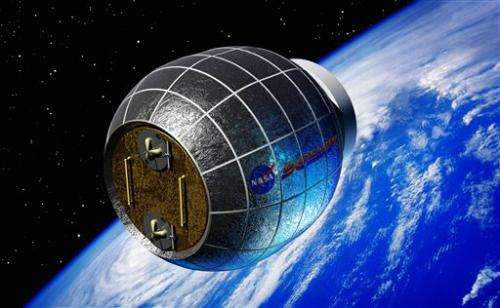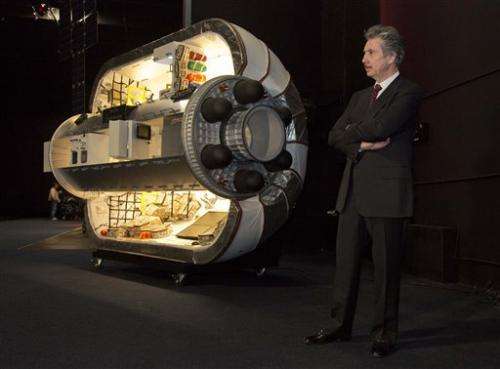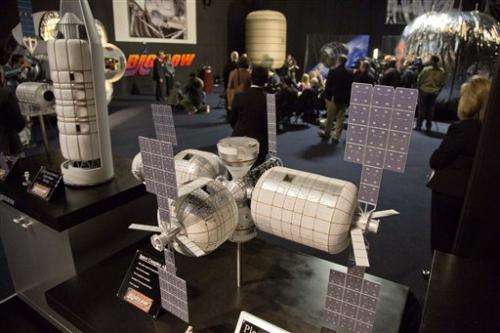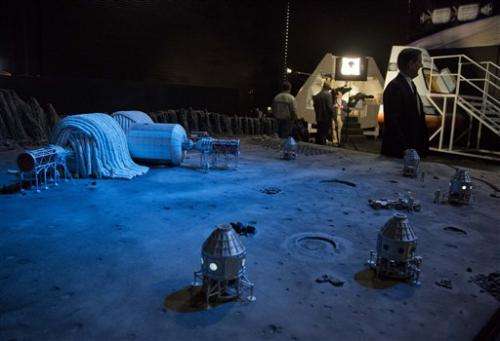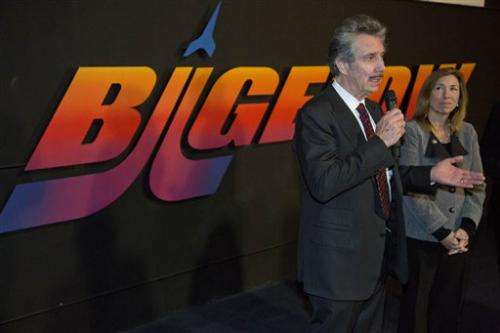This artist's rendering provided by Bigelow Aerospace shows a Bigelow inflatable space station. NASA is partnering with this commercial space company to test an inflatable room that can be compressed into a 7-foot tube for delivery to the International Space Station. NASA is expected to install the module by 2015. (AP Photo/Bigelow Aerospace)
NASA is partnering with a commercial space company in a bid to replace the cumbersome "metal cans" that now serve as astronauts' homes in space with inflatable bounce-house-like habitats that can be deployed on the cheap.
A $17.8 million test project will send to the International Space Station an inflatable room that can be compressed into a 7-foot (2.1-meter) tube for delivery, officials said Wednesday in a news conference at North Las Vegas-based Bigelow Aerospace.
If the module proves durable during two years at the space station, it could open the door to habitats on the moon and missions to Mars, NASA engineer Glen Miller said.
The agency chose Bigelow for the contract because it was the only company working on inflatable technology, said NASA Deputy Administrator Lori Garver.
Founder and President Robert Bigelow, who made his fortune in the hotel industry before getting into the space business in 1999, framed the gambit as an out-of-this-world real estate venture. He hopes to sell his spare tire habitats to scientific companies and wealthy adventurers looking for space hotels.
NASA is expected to install the 13-foot (4-meter), blimp-like module in a space station port by 2015. Bigelow plans to begin selling stand-alone space homes the next year.
Bigelow Aerospace founder and president Robert Bigelow, listens to questions from members of the media during a news conference, Wednesday, Jan. 16, 2013, in Las Vegas. Bigelow spoke about the company's new contract to provide NASA with a habitat module for the International Space Station. Pictured with Bigelow is a BA 330 module, similar in function to what the new Bigelow Expandable Activity Module will be. (AP Photo/Julie Jacobson)
The new technology provides three times as much room as the existing aluminum models, and is also easier and less costly to build, Miller said.
Artist renderings of the module resemble a tinfoil clown nose grafted onto the main station. It is hardly big enough to be called a room. Miller described it as a large closet with padded white walls and gear and gizmos strung from two central beams.
Garver said Wednesday that sending a small inflatable tube into space will be dramatically cheaper than launching a full-sized module.
"Let's face it; the most expensive aspect of taking things in space is the launch," she said. "So the magnitude of importance of this for NASA really can't be overstated."
A model of a space complex is on display during a news conference with Bigelow Aerospace president Robert Bigelow and NASA deputy administrator Lori Garver, Wednesday, Jan. 16, 2013, in Las Vegas. NASA has awarded a contact to Bigelow Aerospace to provide NASA with a Bigelow Expandable Activity Module, a habitat module for the International Space Station. (AP Photo/Julie Jacobson)
The partnership is another step toward outsourcing for NASA, which no longer enjoys the budget and public profile of its heyday. The agency has handed off rocket-building to private companies, retired it space shuttles in 2011 and now relies on Russian spaceships to transport American astronauts to and from the space station.
Astronauts will test the ability of the bladder, known as the Bigelow Expandable Activity Module, or BEAM, to withstand heat, radiation, debris and other assaults. Some adventurous scientists might also try sleeping in the spare room, which is the first piece of private real estate to be blasted into space, Garver said.
Bigelow said the NASA brand will enable him to begin selling Kevlar habitats several times the size of the test module.
A model of a concept space station made with Bigelow Aerospace habitat modules is on display at the company's headquarters during a news conference, Wednesday, Jan. 16, 2013, in Las Vegas. NASA has awarded a contact to Bigelow Aerospace to provide NASA with a Bigelow Expandable Activity Module, a habitat module for the International Space Station. (AP Photo/Julie Jacobson)
"This year is probably going to be our kickoff year for talking to customers," he said. "We have to show that we can execute what we're talking about."
Bigelow, who launched a small prototype of the module in 2006 after licensing the patent from NASA, will rely on Boeing Co. and Southern California rocket developer Space Exploration Technologies to provide transportation.
A 60-day stay will cost $25 million, which doesn't include the $27.5 million it costs to get there and back.
Bigelow predicted that the primary customers will be upwardly mobile countries including Brazil, Singapore and the United Arab Emirates that "have a difficult time getting their astronauts into orbit" and could use a private space station to barter and build up prestige.
The biggest technological challenge will be transporting the collapsed module through the sub-zero temperatures of space without tearing or cracking any part of it, Miller said.
Bigelow Aerospace president Robert Bigelow, left, and NASA deputy administrator Lori Garver answer questions for the media during a news conference, Wednesday, Jan. 16, 2013, in Las Vegas. NASA has awarded a contact to Bigelow Aerospace to provide NASA with a Bigelow Expandable Activity Module, a habitat module for the International Space Station. (AP Photo/Julie Jacobson)
When it arrives at the space station in 2015, scientists will blow it up and let it sit for a few days to test for leaks. If it does not hold as promised, NASA will take back a portion of the already bargain basement price it paid Bigelow.
Standing beside scale models of research stations on Mars and the moon, Miller said the project will encourage commercial ventures to follow the path NASA blazes into space.
He added that it could also help achieve the holy grail of space exploration: missions that send astronauts out of orbit for more than a year.
"The only way to do that is to expand it out and voila you have living space for three people to go to Mars," he said. "You can get three times the volume of a metallic can, and you can go up in the same ferry."
Copyright 2013 The Associated Press. All rights reserved. This material may not be published, broadcast, rewritten or redistributed.
